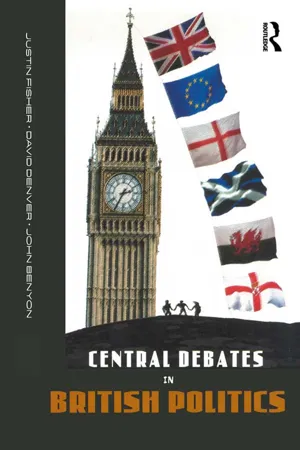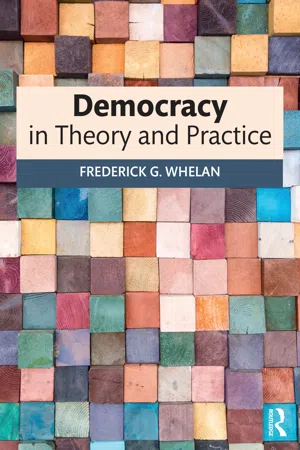Politics & International Relations
Additional Member System
The Additional Member System is an electoral system that combines elements of both proportional representation and first-past-the-post systems. Under this system, voters cast two votes - one for a specific candidate in their constituency and another for a political party. The additional members are then elected from party lists to ensure that the overall distribution of seats reflects the proportion of votes received by each party.
Written by Perlego with AI-assistance
Related key terms
1 of 5
3 Key excerpts on "Additional Member System"
- eBook - ePub
- John Benyon, David Denver, Justin Fisher(Authors)
- 2014(Publication Date)
- Routledge(Publisher)
Other democratic arguments in favour of electoral reform are based on the specific advantages of particular systems and are more difficult to measure. Any system with a list element, for example, is likely to benefit the representation of women and ethnic minorities, as parties can use strategies to ensure that such candidates can be represented on the list. But this advantage is difficult to quantify and in any case, Phillips (1998) has shown that it is extremely difficult to argue for the democratic benefits of social representation in the legislature on normative grounds. Preferential systems, such as the Alternative Vote and the Single Transferable Vote, allow voters to give expression to multiple preferences which may reveal important underlying trends in popular opinion (Dunleavy and Margetts, 1994). They clearly deliver more choice than FPTP, as voters effectively have more than one vote to cast. Mixed-member systems, such as the Additional Member System, allow voters to retain a constituency link while still increasing proportionality. AMS also delivers greater choice than FPTP, because voters choose at both the constituency level and the top-up level. List PR systems, alternatively, where voters vote for party lists and are unable to choose between candidates (‘closed-list’ systems) clearly deliver least choice of all, although there are variants where voters can nominate their preferred candidates (‘open-list’ systems).The extent to which electoral systems deliver stable government, and therefore satisfies the Democratic Audit’s criteria in ensuring that ‘the composition of Parliament and the programme of government reflect the choices actually made by the electorate’, is perhaps the most difficult of all to quantify. FPTP does tend to deliver single-party government due to its ‘leaders’ bias’ effect that favours large parties. Governments elected under FPTP have a party mandate which offers a mechanism for linking electoral preferences to government action through the central party role in both; such mandates are less clear for coalition governments. However, opponents of proportional representation have argued that both coalition governments have been inherently unstable (citing Italy) and too stable (citing Germany): ‘the fact is that there are many different kinds of coalition in Western Europe alone’ (Dunleavy et al., 1998: 20). Furthermore, research has shown that coalitions can still allow parties to keep their commitments owing to agreements among the partners which let each pursue their own differing priorities (see budge, 1998). - eBook - ePub
- Frederick G. Whelan(Author)
- 2018(Publication Date)
- Routledge(Publisher)
supplementary member ) systems similarly combine both single-member districts (using either plurality or sometimes runoff elections) and larger, multi-member list-proportional districts; it is held to have the same advantage of producing a legislature composed of members chosen on both a party and a single-member-district basis. Voters similarly vote twice, for a candidate or party in each type of district. There is a wide variety in the relative numbers of the two types of seats, and parallel systems do not use the party seats to compensate for disproportionality in the single-member district seats; hence they yield only semiproportionality in the legislature. This system is used in Japan and Mexico and has been adopted by some newer democracies, including South Korea and Taiwan.Mixed and parallel voting systems indicate that electoral methods are not mutually exclusive. Not only may a country use different voting methods for different offices and elective bodies (such as the two chambers of a bicameral legislature), but two methods can be combined in choosing the members of the same body, notably a single parliamentary chamber. Such procedural diversity renders the political system more complicated, and thus more difficult for ordinary citizens to grasp, but it may combine the beneficial features of simpler approaches to representation.(13) Cumulative voting offers another semiproportional electoral method. In multimember districts, each voter casts as many votes as there are seats to be filled (as in block voting) but may disperse or concentrate them among the candidates in any combination. Organized minority groups (or other single-issue groups) can often elect representatives of their choice if they can settle on one candidate and get all group members to cast all their votes for that candidate.Cumulative voting was employed in the unique case of the Illinois House of Representatives from 1870 to 1980, where its original purpose was to ensure the election of some Republicans from the Democratic south of the state and some Democrats from the Republican north–an example of minority or proportional representation on a party basis. This electoral method has begun to be used in some local US jurisdictions, where it is held to provide a legal means of facilitating (though not ensuring) the election of ethnic minority-group officials.38 - eBook - PDF
Comparative Hong Kong Politics
A Guidebook for Students and Researchers
- Mathew Y. H. Wong(Author)
- 2017(Publication Date)
- Palgrave Macmillan(Publisher)
This is what the other design seeks to improve on. The more complicated version of the mixed system is called the Mixed Member Proportional (MMP) system, which is used in Germany and New Zealand. The difference in the MMP is that the results of the two electoral segments are dependent. Voters cast two votes: one each for a candidate at the district level and a party at the national level (it is possible to vote for a party A candidate in the constituency but party B in the party vote). The first vote is just used for electing the plurality winner in single-member districts. The second party vote is aggregated nation-wide, producing a ‘desired’ distribution of seats across parties. However, instead of allocating the other segment proportionally according to this distribution (which is similar to what the simple one does), seats are allocated with the aim of eventually achieving the desired distribution in the legislature. That means if a party does not do well in the plurality elections at the district level, but receives strong support in the party vote, it would be allocated relatively more seats in the proportional segment to compensate for the discrepancy, and vice versa if a party does ‘too well’ in plurality elections relative to its overall party support. The final legislature composition, combining both the plurality and the compensating segments, should reflect the distribu- tion of support of parties based on the second vote casted by voters. This 6 In some systems such as Japan voters also cast a separate vote for the proportional segment. ELECTORAL SYSTEMS 186 highlights the strength of the MMP system: maintaining the proportional nature of legislatures while reaping the benefits of single-member districts (representativeness and accountability; see below).
Index pages curate the most relevant extracts from our library of academic textbooks. They’ve been created using an in-house natural language model (NLM), each adding context and meaning to key research topics.


